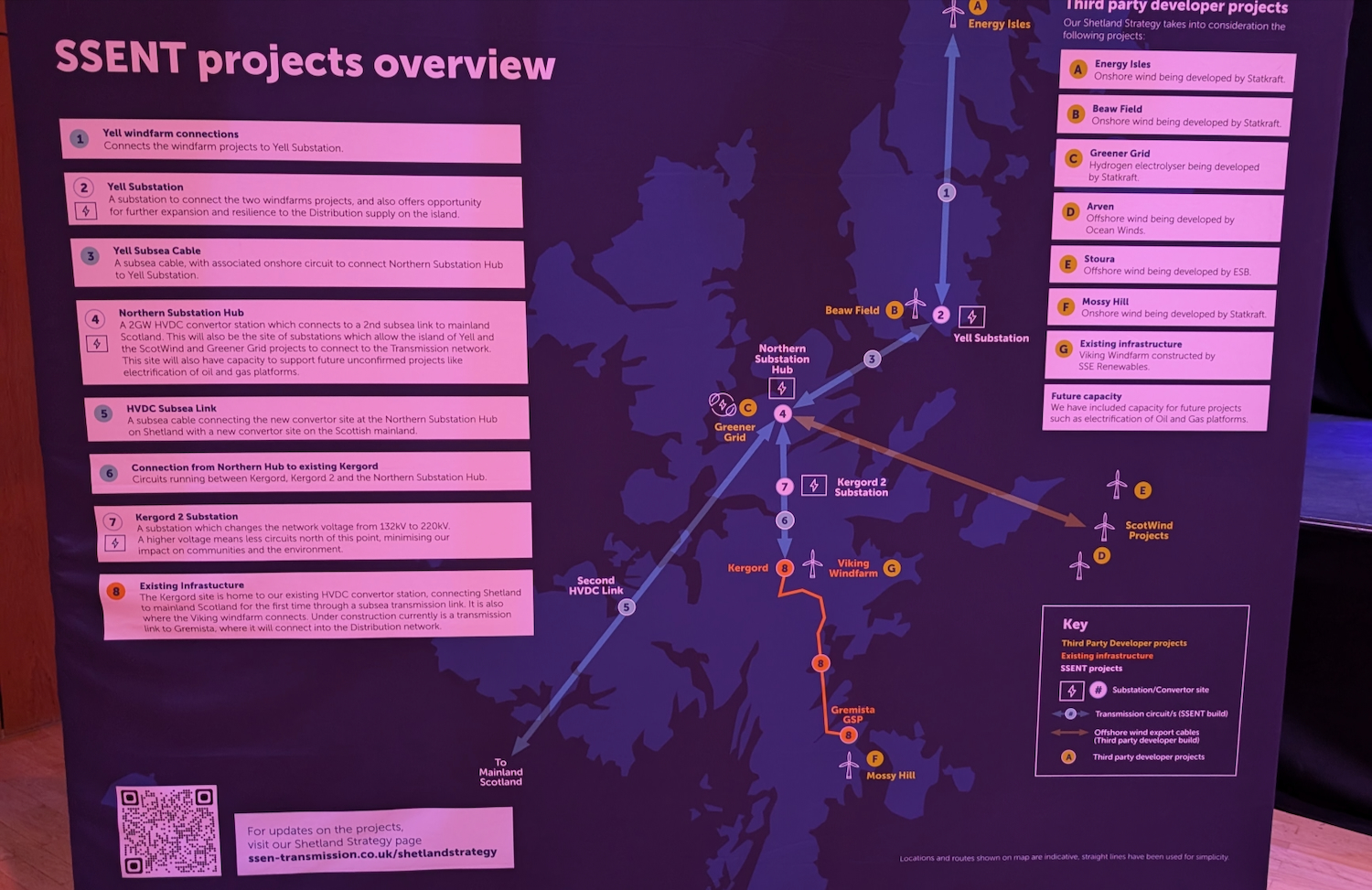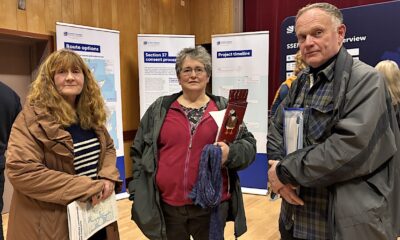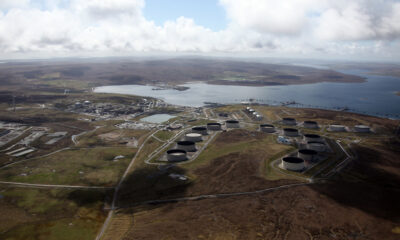Science
SSE Proposes New Substations and Pylons to Enhance Shetland’s Energy Network

Scottish and Southern Energy Networks (SSEN) is exploring plans to construct a new substation and larger pylons in the Kergord area as part of an initiative to upgrade Shetland’s energy infrastructure. This proposed development aims to facilitate future energy projects, including a second high-voltage direct current (HVDC) subsea cable to the Scottish mainland and offshore wind farms east of Shetland.
SSEN is considering larger pylons to support these enhancements, which would be necessary for the new overhead lines between Kergord and a larger 2GW substation hub planned for the Sullom Voe and Scatsta area. If implemented, these projects could generate a one-time community benefit fund worth approximately £2 million, although this payment would not recur annually.
Community Engagement and Future Plans
In an effort to engage local residents, SSEN is hosting a community event at Mareel, allowing the public to interact with various energy developers, including Statkraft and the team behind the Stoura offshore wind farm. SSEN Transmission’s lead project manager, Alan Kelly, emphasized the importance of this event, stating that it was organized in response to feedback from residents who felt disconnected from the broader energy strategy.
“We’re committed to events like this,” Kelly remarked. “People have said ‘you’re not listening’ – if we weren’t listening, we wouldn’t be here. We want to engage with the community.”
Last week’s seminar with local councillors revealed some apprehensions regarding the proposals, particularly concerning the potential installation of steel lattice pylons, which would be used to elevate the voltage from 132kV to 220kV. Kelly acknowledged the visual impact these structures could have, stating, “We understand the impact that these towers would have.”
Infrastructure Development and Environmental Considerations
The existing converter station at Upper Kergord, along with the current substation for the Viking wind farm, forms part of the foundation for these new developments. The proposed second substation, expected to be similar in size to the existing facility, would facilitate the expansion of the energy network.
Kelly explained the necessity of connecting the existing converter station to the new northern hub, emphasizing that “all of the projects need to be connected.” The new overhead lines, which would carry the increased voltage, require larger pylons than those currently in place. He compared the proposed 220kV pylons to traditional four-legged structures, similar to the Bressay transmission mast, though he noted they would not reach the same heights.
The installation of underground cables poses challenges, particularly in peatland areas, where excavation can be both difficult and environmentally damaging. “We have to demonstrate to Ofgem and the National Energy Systems Operator that we are taking the most economic and efficient solution,” Kelly added.
Local councillor Stephen Leask expressed his concerns regarding the visual and environmental impact of the steel pylons, advocating for the use of underground cabling. He highlighted the perceived lack of sensitivity towards Shetland’s landscape and the high energy costs faced by residents.
A second subsea HVDC cable, already in place between Kergord and Caithness, currently allows power export from the Viking wind farm. The proposed new link, which would be three times the capacity, aims to accommodate both offshore and onshore wind developments in the region. The specific landfall location for this second HVDC cable is still under consideration, with potential sites including the North Mainland and Wethersta.
The northern hub, designed to connect with various offshore wind initiatives and Statkraft’s Beaw Field and Energy Isles wind farms in Yell, could be significantly larger than the existing Kergord site, measuring around 800 metres by 500 metres. Kelly confirmed that SSEN will consult the community on the design of the new facilities to ensure they blend into the landscape and minimize visual disruption.
SSEN is also working to ensure that any new infrastructure will not adversely impact local industries, such as aquaculture, as they plan for landfall of the second HVDC cable. Additionally, a new subsea cable from the Shetland mainland to Yell is planned, along with a smaller substation in Yell.
The company has committed to following new UK Government guidelines on energy infrastructure and community benefits. Under these guidelines, SSEN would provide a one-time community benefit of £520,000 for the construction of substations and £200,000 per kilometre of overhead line.
Kelly highlighted the importance of community benefits beyond financial contributions, emphasizing job creation and supply chain opportunities. SSEN continues to engage with local housing associations to address needs arising from the transient workforce involved in project construction.
In conclusion, SSEN’s proposed developments represent a significant step forward in enhancing Shetland’s energy infrastructure, aligning with the region’s future growth and sustainability goals. By actively engaging with the community and addressing environmental concerns, the company aims to foster a collaborative approach to energy development in the area.
-

 Entertainment3 months ago
Entertainment3 months agoAnn Ming Reflects on ITV’s ‘I Fought the Law’ Drama
-

 Entertainment4 months ago
Entertainment4 months agoKate Garraway Sells £2 Million Home Amid Financial Struggles
-

 Health3 months ago
Health3 months agoKatie Price Faces New Health Concerns After Cancer Symptoms Resurface
-

 Entertainment3 months ago
Entertainment3 months agoCoronation Street’s Carl Webster Faces Trouble with New Affairs
-

 Entertainment3 months ago
Entertainment3 months agoWhere is Tinder Swindler Simon Leviev? Latest Updates Revealed
-

 World2 weeks ago
World2 weeks agoBailey Announces Heartbreaking Split from Rebecca After Reunion
-

 Entertainment4 months ago
Entertainment4 months agoMarkiplier Addresses AI Controversy During Livestream Response
-

 Entertainment2 weeks ago
Entertainment2 weeks agoCoronation Street Fans React as Todd Faces Heartbreaking Choice
-

 Science1 month ago
Science1 month agoBrian Cox Addresses Claims of Alien Probe in 3I/ATLAS Discovery
-

 Health4 months ago
Health4 months agoCarol Vorderman Reflects on Health Scare and Family Support
-

 Entertainment4 months ago
Entertainment4 months agoKim Cattrall Posts Cryptic Message After HBO’s Sequel Cancellation
-

 Entertainment3 months ago
Entertainment3 months agoOlivia Attwood Opens Up About Fallout with Former Best Friend





















